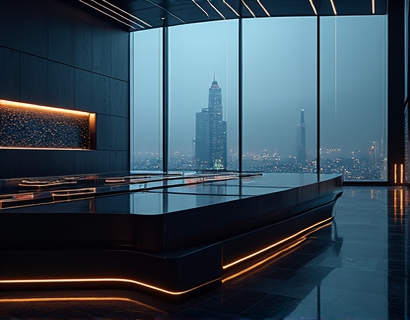Augmented Reality Technology: Expert Reviews and Industry Trends Unveiled
Augmented reality (AR) has evolved from a futuristic concept to a transformative technology reshaping industries and consumer experiences. By overlaying digital information onto the physical world, AR bridges the gap between virtual and real environments, offering innovative solutions for education, healthcare, manufacturing, retail, and entertainment. This article explores the latest advancements in AR technology, expert insights, and emerging trends that define the current and future landscape of this dynamic field.
Understanding Augmented Reality: Core Concepts and Applications
Augmented reality integrates digital elements—such as images, sounds, or data—into a user’s real-world environment in real time. Unlike virtual reality (VR), which immerses users in a fully digital space, AR enhances physical surroundings with contextual information. This distinction makes AR particularly versatile, as it can be accessed through smartphones, tablets, smart glasses, and heads-up displays (HUDs).
Key applications of AR include:
- Education: Interactive learning tools that visualize complex concepts, such as 3D anatomical models for medical students.
- Healthcare: Surgical navigation systems that project patient data during operations.
- Retail: Virtual try-ons for clothing, accessories, or furniture.
- Manufacturing: AR-guided assembly lines that reduce errors and improve efficiency.
- Entertainment: Location-based gaming experiences like Pokémon GO.
Current Trends in Augmented Reality Technology
1. Advancements in AR Hardware
The development of lightweight, high-performance AR glasses and headsets is driving adoption across industries. Companies like Microsoft, Magic Leap, and Apple are refining devices to improve resolution, field of view, and battery life. For example, Microsoft’s HoloLens 2 offers hand-tracking capabilities and a wider visor, making it a preferred tool for enterprise training. Meanwhile, consumer-focused smart glasses, such as Nreal Light, prioritize affordability without compromising on functionality.
2. Integration with 5G and Edge Computing
The rollout of 5G networks enables faster data transfer and reduced latency, critical for real-time AR applications. Edge computing further enhances performance by processing data closer to the source, minimizing reliance on centralized servers. This synergy supports complex use cases like remote assistance, where technicians receive live AR overlays during equipment repairs, even in low-bandwidth environments.
3. Spatial Computing and Environmental Understanding
Modern AR systems leverage spatial computing to map and interact with physical spaces more accurately. Technologies like LiDAR (Light Detection and Ranging) enable devices to detect surfaces, measure distances, and anchor digital objects persistently. Apple’s ARKit and Google’s ARCore have integrated these features, allowing developers to create apps that recognize room layouts or place virtual furniture in a user’s home with precision.
4. Enterprise Adoption and ROI-Driven Solutions
Businesses are increasingly adopting AR to streamline operations and reduce costs. In manufacturing, companies like Boeing use AR headsets to guide technicians through aircraft assembly, cutting production time by 30%. Similarly, retailers deploy AR apps to visualize products in customers’ homes, reducing return rates. Experts highlight that enterprises prioritizing AR report a 40% improvement in task efficiency, according to recent industry analyses.
Expert Reviews: Evaluating AR Hardware and Software
AR Glasses and Headsets
Experts emphasize that the choice of AR hardware depends on use-case requirements. For industrial settings, the Microsoft HoloLens 2 remains a top pick due to its robust build and enterprise-grade software ecosystem. However, its high price point limits accessibility for smaller businesses. In contrast, the Magic Leap 2, with its compact design and advanced dimming technology, is praised for outdoor use but faces criticism for limited app support. Consumer devices like the Ray-Ban Meta Smart Glasses focus on seamless integration with social media, though their AR capabilities are still rudimentary.
Software Platforms and Development Tools
Unity’s MARS and Unreal Engine are leading platforms for AR content creation, offering tools to build cross-platform experiences. Developers commend Unity’s user-friendly interface, while Unreal Engine is favored for high-fidelity graphics. However, both require significant coding expertise, prompting demand for no-code solutions like Adobe Aero, which allows designers to create AR scenes using drag-and-drop features. Experts caution that fragmentation across platforms remains a challenge, as apps optimized for iOS (ARKit) may not perform equally on Android (ARCore).
Content Creation and User Experience
The quality of AR experiences hinges on intuitive design and contextual relevance. Reviewers note that overly complex interfaces or poorly rendered 3D models can deter user engagement. Successful applications, such as IKEA Place, prioritize simplicity, enabling users to place true-to-scale furniture in their living rooms with minimal effort. Additionally, advancements in AI-driven content generation, like NVIDIA’s Omniverse, are automating the creation of realistic 3D assets, reducing development time.
Industry-Specific Applications of AR
Healthcare: Enhancing Precision and Training
AR is revolutionizing medical training and patient care. Platforms like Proximie allow surgeons to stream procedures in AR, enabling remote collaboration. At Johns Hopkins University, neurosurgeons used AR to guide spinal fusion surgery, achieving millimeter-level accuracy. Medical students also benefit from AR anatomy apps, which provide interactive 3D models of organs, improving retention rates compared to traditional textbooks.
Education: Interactive and Immersive Learning
Educators are leveraging AR to create engaging lessons. Apps like Merge Cube let students examine virtual fossils or planets by holding a physical cube, while platforms like Google Expeditions offer virtual field trips to historical sites. Studies indicate that AR-enhanced classrooms see a 25% increase in student participation, as visual and interactive elements cater to diverse learning styles.
Retail: Personalizing the Shopping Experience
Retailers use AR to bridge the gap between online and in-store shopping. Sephora’s Virtual Artist app allows customers to try makeup shades via their smartphone cameras, while Warby Parker’s app simulates how glasses look on a user’s face. These tools reduce purchase hesitation and drive conversion rates by up to 30%, according to retail analysts.
Manufacturing: Reducing Errors and Downtime
In manufacturing, AR overlays provide real-time guidance during assembly or maintenance. Porsche’s Tech Live Look connects technicians with remote experts via AR glasses, enabling hands-free troubleshooting. This approach has reduced repair times by 40%, as technicians no longer need to consult manuals or wait for on-site support.
Challenges and Limitations in AR Adoption
Technical Constraints
Despite progress, AR faces hardware limitations, such as short battery life and limited field of view. Most AR glasses offer 2–3 hours of continuous use, restricting their utility for prolonged tasks. Additionally, rendering high-quality 3D graphics in real time demands significant processing power, which can cause overheating in mobile devices.
Privacy and Ethical Concerns
AR’s ability to collect spatial data raises privacy issues. For instance, apps mapping indoor environments could inadvertently capture sensitive information. Experts urge policymakers to establish clear guidelines on data ownership and user consent, akin to GDPR regulations for digital privacy.
Content Fragmentation and Standardization
The lack of universal standards for AR content creation leads to compatibility issues. An app designed for Meta’s Quest headsets may not function on HoloLens, forcing developers to build multiple versions. Industry consortia like the Open AR Cloud Alliance are working to create interoperable frameworks, but widespread adoption remains years away.
Future Trends Shaping the AR Landscape
1. Convergence with Artificial Intelligence
AI is enhancing AR through object recognition, natural language processing, and predictive analytics. Future AR systems could use AI to identify objects in a user’s environment and provide contextual information—for example, translating street signs in real time or suggesting recipes based on ingredients in a refrigerator.
2. Wearable AR as a Mainstream Consumer Product
Analysts predict that AR glasses will follow a trajectory similar to wireless earbuds, transitioning from niche to mass-market adoption by 2030. Advances in micro-LED displays and waveguide optics will enable sleeker designs, while lower production costs make devices accessible to broader audiences.
3. Expansion of the AR Cloud
The AR Cloud—a digital replica of the physical world—will enable persistent and shared AR experiences. Imagine playing a location-based game where digital objects remain anchored to specific spots for all users. Companies like Niantic are investing in this technology to create large-scale multiplayer AR games.
4. Ethical AR Design and Digital Wellbeing
As AR becomes ubiquitous, developers must address its impact on mental health and social interaction. Features like “AR fatigue” warnings or focus modes that limit notifications are being explored to prevent sensory overload. Ethical design principles will play a key role in ensuring AR enhances, rather than disrupts, daily life.
Conclusion
Augmented reality is no longer a speculative technology but a practical tool driving innovation across sectors. From healthcare and education to retail and manufacturing, AR’s ability to merge digital and physical worlds offers unparalleled opportunities for efficiency and engagement. However, challenges like hardware limitations, privacy concerns, and content fragmentation require collaborative solutions from developers, policymakers, and industry leaders. By staying informed about emerging trends and expert insights, professionals and enthusiasts can navigate the evolving AR landscape and harness its potential responsibly.











































